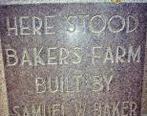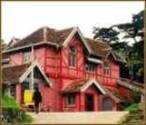History of Nuwara Eliya
|
The modern history of Nuwara Eliya commenced in 1818 when Dr. John Davy, a British Surgeon (and the brother of Humphery Davy, known for inventing the Miners' Safety Lamp), rediscovered this remarkable area. Dr. Davy described his experience:
"I was walking in the midst of a dense forest when I encountered stunning, glistening waterfalls cascading like diamonds. Climbing to the mountain's peak, my companions and I marvelled at the breathtaking views, and they proclaimed it as the highest point in the country." Dr. John Davy noted that Nuwara Eliya was abundant in Ashoka trees, elephants, wild animals, and precious gemstones. Today, the place known as 'Oliphant Estate' was once the 'Elephant Plane,' a habitat for many elephants. Even now, you can find the graves of two individuals known for killing elephants at the Nuwara Eliya Golf Grounds. One reads, 'Ibenishan Gordon Mendrow, Born on November 10, 1814, Died on January 24, 1841 - Perished in the Elephant Plane.' The other inscription belongs to 'Major William Thomas Rogerson, who passed away on June 7, 1814.' Major Rogerson was reputed to have killed more than 400 elephants, and it is believed that his grave is struck by lightning every seven years, with visible damage to the grave near the Golf Grounds. Many consider this a divine punishment for the act of killing elephants. The story unfolds when a few British troops find themselves lost in the forest in pursuit of an elephant. Equipped with provisions, they decided to spend the day and night there. To their surprise, the cool climate and fresh air offered unexpected comfort. They recognised the potential of this place as an excellent retreat after their wartime struggles and promptly informed Governor Sir Edward Barnes upon their return home. Sir Edward Barnes, who served as Governor from 1824 to 1831, played a significant role in developing Nuwara Eliya. He constructed roads, shelters, and his own holiday home, "Barnes Hall," which is now the renowned Grand Hotel of Nuwara Eliya. Other establishments like St. Andrews Hotel, Keena Hotel, and Carlton Hotel also came into existence. District Secretary Mr Loku Banda assisted Sir Barnes in building these holiday homes, earning Sir Edward Barnes the "Father of Nuwara Eliya." Following Sir Barnes, Sir William Horton assumed the role of Governor from 1831 to 1837. He was also the editor of the 'Colombo Journal' newspaper and wrote numerous articles about Nuwara Eliya. During this era, Mr Samuel Baker arrived in Nuwara Eliya from England with ambitious plans to create a house in Magasthota and a vast vegetable and animal farm. His brothers, John and Valentine, accompanied him, along with farming experts. They faced challenges in transporting goods and animals from Colombo using bullock carts. Tragedy struck near Ramboda Pass, where Mr Samuel's brothers lost their lives. From Ramboda, Mr Samuel hired labourers to complete the transportation to Nuwara Eliya, where he established an agricultural village called 'Baker's Farm.' Remarkably, the land cost him a mere 25 Shillings per acre; today, a 'stone letter' still stands at Baker's Farm. In memory of his late brothers, Mr Samuel Baker established a hospital ward at the Base Hospital of Nuwara Eliya, the 'Baker's Ward.' Additionally, Mr. Baker attempted to cultivate grapes, oats, barley, and wheat, typically grown in lower temperatures. Unfortunately, his experiment failed, leading to the closure of his farm in 1866, after which he returned to England. To honour Mr. Samuel Baker, Sri Lanka named its widest waterfall in Horton Plains National Park 'Bakers Falls.' Governor Sir William Gregory (1872-1877) envisioned making Nuwara Eliya the capital of Sri Lanka. He implemented various proposals for Nuwara Eliya's development, including the creation of 'Gregory Lake' by draining a swamp, now a popular city attraction. Governor Gregory also highlighted Nuwara Eliya's unique features to the world, emphasising its luxurious and cool climate, fertile land suitable for crops like Coffee, Tea, and 'Cinkona,' and its suitability for animal farming and gem mining. Governor Gregory's announcement drew the attention of foreign merchants to Nuwara Eliya, leading to a rise in the city's population. Subsequently, Sir Robert London (1877-1884), following Sir William Gregory's advice, constructed a railway track from Peradeniya to Nawalapitya and further to Hatton and Nanu Oya. By 1910, only two Sri Lankans owned houses in Nuwara Eliya: Maha Mudali Sir Soloman Dias Bandaranaike, father of S.W.R.D. Bandaranayake (later Prime Minister of Sri Lanka), and F.C. Loos. After World War I ended in 1918, more Sri Lankans purchased land and built houses in Nuwara Eliya. Some prominent names included Sir Ponnambalam Arunachalam and E.L.F. De Soyza. Interestingly, while Samuel Baker had paid around Rs. 25/- per acre, Sir Ponnambalam paid Rs. 10,000/- for half an acre! Other noteworthy details: British civil servants, high-ranking government officials, and businessmen frequented Nuwara Eliya during hot and balmy months, particularly April. The plains introduced trout fishing to streams in Horton Plains and Nuwara Eliya. Governor West Ridgeway recommended painting all roofs red, a practice that many followed until recently. Many houses in Nuwara Eliya were constructed in the architectural style of Tudor houses in England, with some featuring fireplaces. 'Thawalanthenna,' a small city along the Nuwara Eliya - Peradeniya main road, was a resting point for travellers with bullock carts in historical times. 'Kelegalle' and 'Kalukelle,' villages located 1.5 km from Nuwara Eliya town, served as resting places for bulls used to transport goods from Nuwara Eliya to other parts of the country. Source: Nuwara Eliya Municipal Council website |




